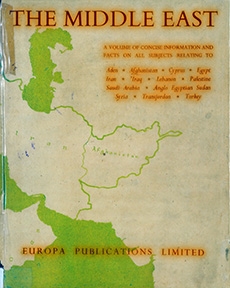|
PREFACE
THE purpose of this new reference book is to give factual data on thirteen countries situated in the area termed by the contemporary strategists “The Middle East”.
For ease of reference, a standard method of study has been adopted throughout the volume so that each country is treated in-the same way. A synopsis of subjects for each country has been added to enable the reader to refer rapidly to those particular items which happen to interest him. Whilst the arrangement is especially suitable for such people as Government officials, diplomats, journalists, librarians, and others who require a connected story, our aim has been to ensure that the volume will also serve the needs of people engaged in business, such as bankers, merchants, and shipowners, who will find in it useful economic data as well as detailed lists of people and firms in the various spheres of commercial activity. Moreover, a guide to the academic, scientific, and cultural attainments of each country is provided by means of a detailed reference to the press, educational system, universities, learned societies, research institutions, museums, and libraries.
The attention of readers interested in religion is drawn to the special articles on Judaism in the Palestine section, and Islam in the Saudi Arabian section. The vexed question of how Arabic words should be spelt has led us to follow the spelling indicated to us by the officials of the various countries. It is appropriate here to observe in passing that the name of the founder of Islam is spelt in more than thirty ways in English.
We wish to express our gratitude to all those who have so willingly given valuable advice and have taken pains to collect and send us material. We especially wish to thank the Governments of Afghanistan, Egypt, Iran, ‘Iraq, Saudi Arabia, Syria and the Lebanon, Transjordan, and Turkey, and their respective Embassies and Legations in London, as well as the Governments of Aden, the Anglo-Egyptian Sudan, and Cyprus, for the many kindnesses extended to us.
The data on Palestine are valid only up to the termination of the Mandate; the course of events in that disturbed country after May 15th, 1948, when the British Govern¬ment ceases to be the Mandatory Power, is at present (April 1948) impossible to foretell, and we therefore make no attempt to offer our speculations on the subject. However, we are grateful to the Arab Office in London and the London branch of the Jewish Agency for their guidance and assistance in matters concerning the experience of the Arab and Jewish communities in Palestine during the Mandate.
We regret that it has not been possible to include in this edition any reference to the Kingdom of the Yemen, the Sultanates of Muscat and Oman, and the other small Moslem countries situated in the Arabian Peninsula,
The League of Arab States
The League of the Arab States, which came into exist¬ence at the conclusion of the Cairo Conference on March 22nd, 1945, represents a stage in the natural development of the modern movement for Arab unity, which began with the birth of Arab nationalism about the middle of the nineteenth century. The movement, at the start more or less visionary, has now taken definite shape in the form of the League. The objects of the Arab League, as set out in the Covenant, are as follows:
(1) To protect and safeguard the integrity and inde- - pendence of the member states.
(2) To ensure that within the framework of the regime and the conditions prevailing in each state, close co-operation between the member states should exist in economic and financial affairs, and in matters connected with nationality, passports, visas and extradition, social matters, advancement of education, and public health.
Viewed from another angle, the League may be regarded as an .attempt at regional planning, designed to establish peace and stability in an area considered to be one of the most important strategic, political, and commercial centres of the world. The League came into existence a few months after the conference at Dumbarton Oaks (Washington, D.C., August 21st to October 7th, 1944), which discussed regional planning as part of the greater organisation for world peace and security. Special attention was, there¬fore, devoted to making the League fit in with this scheme so as to represent an Arab contribution towards better international relationships, understanding, and co-opera¬tion. The Charter of the subsequently-formed United Nations (which formally came into existence on October 24th, 1945) is based upon the proposals agreed upon at Dumbarton Oaks.
The official title of the League is “The League of Arab States". There is no permanent President, but the Secretary-General (Azzam, Abdel Rahman Pasha, an Egyptian) has held his post since the League began. The League functions through a Council and a number of sub¬committees, the chairmanship of the Council being held in rotation by representatives of the member States. The Secretariat of the League is situated in Cairo.
The following representatives of the member States of the Arab League were present at the signature of the Covenant in March 1945:
…..
|
